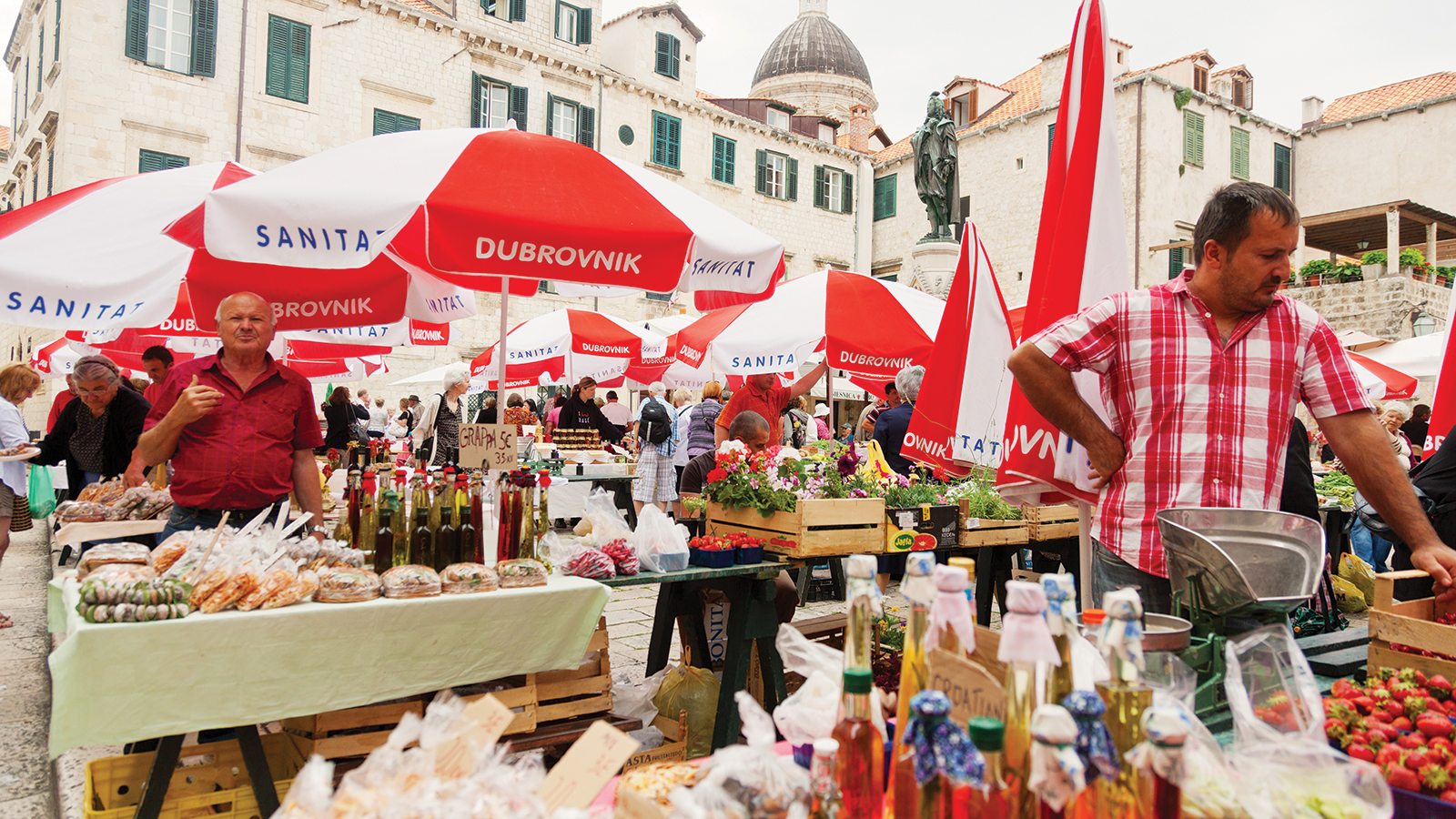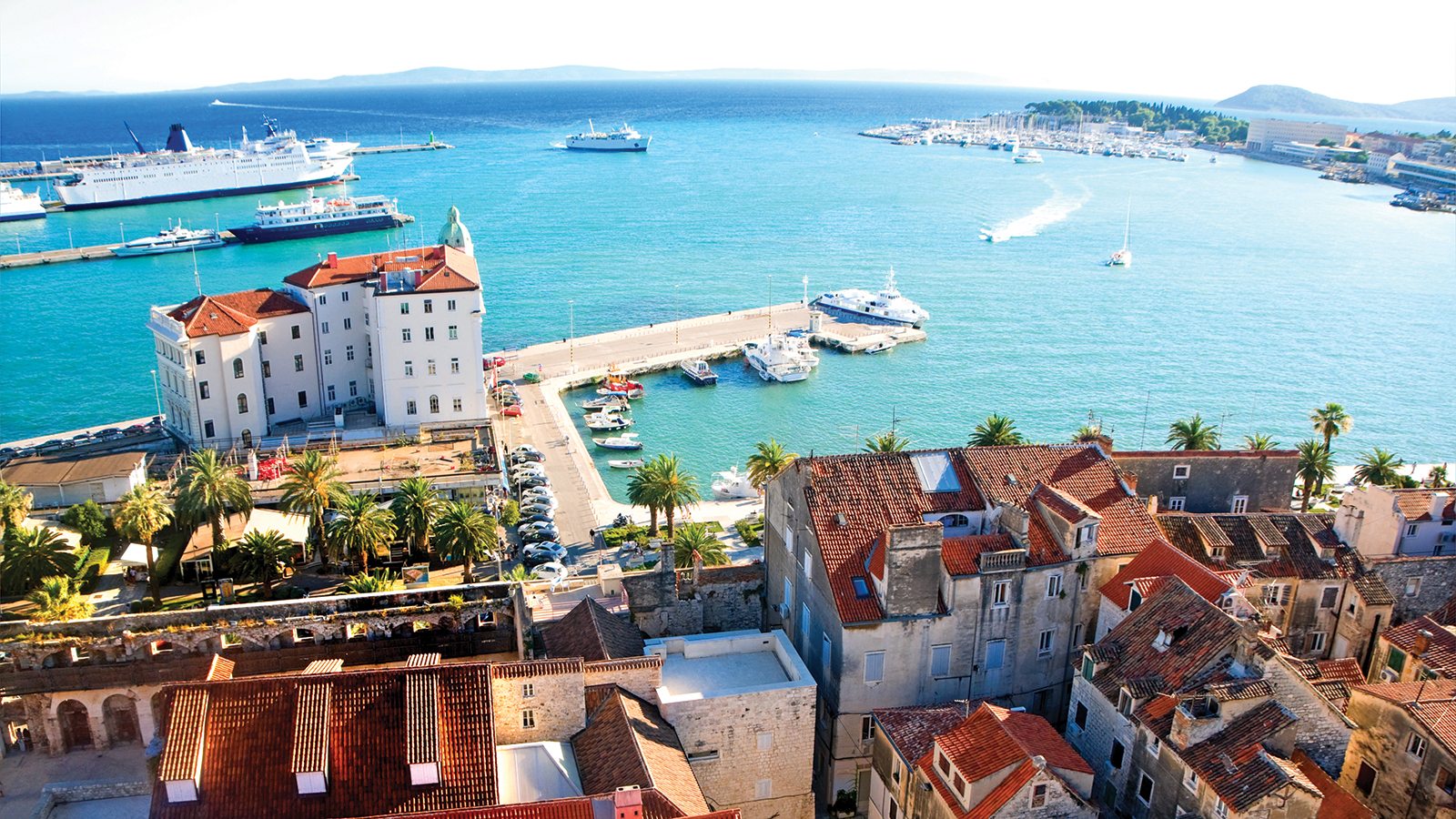The Romans loved their luxury, so it’s no surprise they found the landscapes, burgeoning wine production and all the must-haves of a Mediterranean diet to be attractive lures when they arrived on Croatia’s Dalmatian Coast.
Today, it’s a particularly popular destination for sun-worshippers and honeymooners alike. As my tour group heads south along the coast, it’s hard to believe that just a couple of decades ago the country was fighting for its independence. We are greeted by serene scenes, each more peaceful than the last. And while it’s only April, the weather is already showing off the subtropical mix of the landscape—flowers are blooming, oranges are ripening on trees and palm branches offer shade from the sun.
“Croatia is a great example of the mixture of past influences from so many neighbouring countries, which makes it such a fascinating country to explore,” says our tour director, Karin Kollarova.
We begin our journey in Split, the largest city of the Dalmatian Coast. It claims a lengthy lineage of its own, trailing back to the time of the Greeks, who established the colony of Aspalathos in the sixth century BC. The Romans created the Province of Dalmatia, and Emperor Diocletian, who ruled the empire from AD 284 to 305, chose to retire here.
Diocletian built his palace on the waterfront at the beginning of the fourth century. Today, his home in Old Town Split is one of the best-preserved Roman structures, a UNESCO World Heritage Site and the heart of the Riva area of the old city. The palace’s underground complex is a series of rooms that once stored food and wine, but we see that some parts have been made into homes. Our guide tells us that, in later centuries, it became inhabited by locals and was used as water storage for Old Town Split. It’s also become one of the places that attracts fans of TV’s Game of Thrones, parts of which are shot here.
ON THE WATER
River cruises are a great way to see even more of Europe, Asia and beyond. AMA cruise specialists can help you book flights, hotels, and transportation to and from port, arrange for added member benefits, and offer support before, during and after your trip.
Our group meets up in the palace’s court. We gaze at the soaring bell tower and snap photos of one of Diocletian’s favourite sculptures: a metre-high Egyptian sphinx. Now known as the Cathedral of Saint Dominus, the for-mer mausoleum of Diocletian was
consecrated in the seventh century, and is considered to be the oldest Catholic cathedral in the world mostly retaining its original structure without any major renovations to date.
Time has transformed the Old Town, as locals moved and started businesses within the palace walls. Cobblestone corridors are now a maze of boutiques, cafés, studios and souvenir shops. The buildings are made from Croatian limestone—the material of choice for centuries, as it’s easy to cut and has a luminous white shade. Often referred to as the gold standard of building materials, Croatian limestone was used extensively in Venice and even to build the White House.
Moving on from Split the next day, our coach heads south, bringing us views of the calm Adriatic Sea. Off in the distance are the islands of Brac, Hvar and Vis, popular for summer vacations and known for olives, lavender, sardines and viticulture, especially the Plavac Mali grape, a Croatian red wine varietal.

Passing through the Neretva River Valley, we stop at a roadside stand for tastes of the local bounty: oranges, lemons, figs, almonds and olives. Sugar-coated orange and lemon peels and dried fruit make for a satisfying mid-morning snack as the coach descends from the mountains back down to sea level.
Arriving in the village of Mali Ston on the Peljesac Peninsula, the imposing, five-kilometre-plus Wall of Ston comes within our sights. Nicknamed the “European Great Wall,” it was built by the Dubrovnik Republic that took control of this area in the 14th century to protect it from European invaders.
On the water’s edge, the old tower speaks to the village’s past as part of the defense of the region’s salt production. Now this sleepy village attracts tourists because of its other historic claim to fame: oysters. European flat oysters have been farmed in these waters for more than 700 years. Locals boast that former Yugoslavian leader Josip Tito loved the local molluscs; Napoleon Bonaparte supposedly indulged as well.
MEMBER SAVINGS
Travellers to Europe can enjoy savings of 10% or more at Best Western hotels across the continent. Members also save up to 20% and earn $25 in reward dollars on Hertz car rentals.
For Pero Sare, owner of the restaurant Bota Sare, this area is home. In the late 1980s, the Sare family chose to build their restaurant here—not just because it’s where they’ve lived for decades, but also because Mali Ston is an eco-protected zone, and Sare wanted to continue the local tradition of farming oysters. “Because of the wine and the clean waters offering exceptional seafood, Croatians have always wanted to come to Mali Ston,” he says. “In recent years, as tourists discover what we have to offer, they tell friends to come taste our Croatian oysters.”
We’re taken to the oyster farm via boat and we encounter oysters of all sizes dangling on strings in the salt water. Quickly harvested and shucked by one of Sare’s farmers, the coastal delicacy slides across my palate, accompanied by its briny sea scent. It’s followed by lunch on the terrace at Bota Sare, which turns out to be a Bacchanalian feast: grilled octopus, steamed mussels, lobster and shrimp, and copious chilled glasses of Croatian Posip, a popular type of white wine.
After making our way back to the Dalmatian mainland, our coach takes us through hillsides covered in vine-yards. There’s time for a quick wine and a liqueur tasting at Vina Vukas before we arrive in Dubrovnik.

Our first sight of the city is the modernist Franjo Tudjman Bridge, linking the coastal road to the new port of Gruz. Medieval towers greet us as we pull up to the Pile Gate—the western entrance to the walled city is just steps from Onofrio’s Fountain, which has provided the locals with drinking water since the 15th century.
Established as a trading port in the early Middle Ages, the city boasts limestone defense walls that have protected it since the late eighth century, and which have earned it a UNESCO World Heritage Site designation.
RELATED CONTENT
Travelling the mighty Mekong River to discover Cambodia and Vietnam
It’s a must to stroll along the top of Dubrovnik’s walls, which can take 90 minutes to two hours, depending on crowds and the need to stop for a coffee or beer along the way. The walk reveals numerous cafés, B&Bs and a look at local life—comprised mostly of older folks, as the younger set have moved beyond the city walls to newer neighbourhoods and enclaves.
Inside the walls, a walking tour takes us up and down endless staircases, through narrow lanes like the popular “restaurant street”
(Prijeko Street) and to the Jewish Quarter. Down more stairs and we’re back on Placa, the main street of the Old City, where tourists are buying souvenirs of olive oil and lavender, lining up for gelato in the shadow of St. Saviour Church or wandering the quiet enclave of a nearby Franciscan monastery. Our guide shows us Fort Lovrijenac, and shares the locations where Game of Thrones is filmed.
Leaving behind the crowds of Dubrovnik’s Old City, our last night is spent on a boat cruising the harbour. As we take in the view, we offer up a toast to this country, which presents palate-pleasing vintages, a wealth of European history and a taste of Dalmatian hospitality. Paradise in the 21st century.
